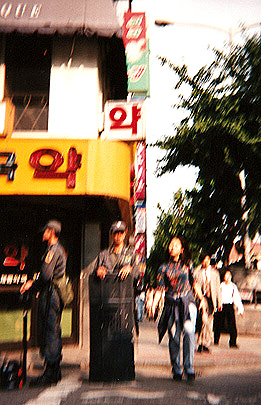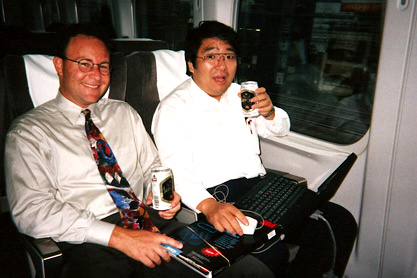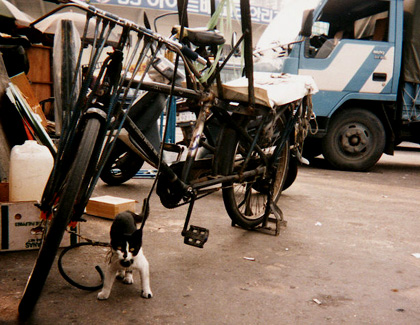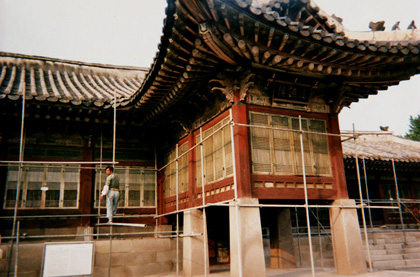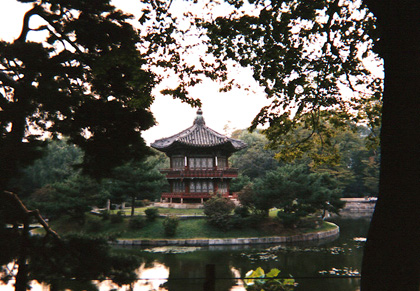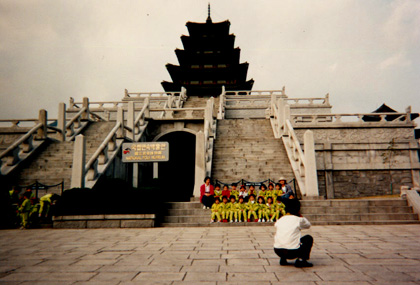|
Featuring: a failed technical seminar, two "propositions", a Korean disco,
and a very large number of riot police...
In September of 1995 I traveled briefly to Japan and Korea (as well as the U.S.) to present a series of technical seminars organized by a local representative of my former employer, Data I/O Corporation. At the time that I made this particular trip I had already resigned from Data I/O (after trying and failing the previous year to be laid off) and was in the process of forming a new company. My new startup, Accolade Design Automation, would compete rather directly with the existing software products of Data I/O, including the products that were to featured at these technical seminars. (What can I say? I needed the money.) This put me in a somewhat odd position for the six or so months that I was contracted to do these events, and I only agreed to do them if my part of the session was strictly educational, and that product sales pitches and demos would be done by actual Data I/O personnel. I would educate and endorse a particular method of design (I had published a book or two and was presumably some kind of expert in the field, although in fact I wasn't), while it was up to their guys to demonstrate why their particular tool was the best one for that method. For whatever reason, nearly all of these seminar trips became misadventures of one form or another. Perhaps this was due to my somewhat detached and uncertain mood at the time. Read on... Japan The Tokyo and Osaka technical seminars had gone well, with large numbers of attendees and good questions. Mike and Renji (of Data I/O) were entertaining traveling companions, and I managed to have a reasonably good time during the trip. But as a result of not really wanting to be a part of the company I'd spent almost 13 years working for, I tried to get away by myself during this trip, perhaps to the point of seeming rude. When Mike and Renji had business to talk about, such as potential new customers or improvements they thought should be in the products, I would bury myself in a book or go off for very long side trips to find a bottle of juice, or make some other excuse about needing to make a phone call, or work on my presentation slides, or whatever. I had arranged to be in Japan a few days before Mike arrived, which gave me some time to meet with my friend Katsumi, who was considering representing my new company and selling its products in Japan. This was an obvious conflict with my seminar work, so I didn't make any mention of it to Mike or Renji, both of who knew Katsumi. He had also worked previously at the same company, for nearly as long as I had. In my hotel in Tokyo (the New Otani, I believe) I had gone for a walk after having dinner with Katsumi and, typically, had been out for two or three hours, walking miles and miles through the neighborhoods trying to loosen the cramps from my legs after too many hours of sitting, on the airplane from Seattle, and on the train from Narita and at the restaurant. When I returned to the hotel near midnight I found myself on the wrong side of it, one floor down from the main lobby. I entered through a rather dimly-lit back entrance and walked toward the elevator. Sitting in a chair near the elevator was a girl, perhaps 18, who looked Japanese at first glance, but at second glance appeared to be half something else, perhaps African or Indian. She was dressed in a sweater and short skirt, and as I neared the elevator she rose from the chair, pushed the button (the elevator only went up) and stood next to me until the door opened. I noticed then that she was quite short, probably less than five feet tall. I stepped into the elevator, and so did she. "Which floor?" She said in slightly accented English. I told her and she pushed that button. "Do you want a girlfriend tonight?" she said. I didn't know what to say in response. This was the first time I had been propositioned by a hooker, and it seemed strange that it would happen in a Japanese hotel, where such things were (or so I thought) rather strictly controlled, and not the domain of free-agent prostitutes. I said "uh, no... actually no, I, uh...", or something like that, and then we were at my floor. I left the elevator, the door closed and she was gone. I mentioned this the next day to Renji, and he was also surprised at the directness of the approach. "That's like in America," he said, although he didn't elaborate on his apparent international expertise.
Mike and Renji (both of Data I/O) on the Shinkansen Korea The trip to Seoul from Osaka was quick and easy. This was my first time transiting through Kansai airport, which was built in a formerly pristine bay near Osaka, and was later determined to be gradually sinking into the ocean. It is a huge airport, with a decor like something out of a sci-fi movie, with all the soaring beams, glass and chrome. Upon arriving in Seoul via taxi-limo, my first impression of the city was that it looked a lot like a Japanese city, but a little smoggier, and a little more industrial. There was little, if any, use of English on signs or buildings so I couldn't read anything. Japan had me spoiled in that regard. But in the business districts, like the newer area in which our hotel was located, the appearance was very similar to Japan, but also a little more like America in that the streets were wider and the buildings set back from the roads. The feeling was not so tight and claustrophobic as in Tokyo or Osaka. Coming in from the airport I got the immediate sense that the U.S. military has a big presence. There was a military radio station playing in the car with rock-and-roll music and American propaganda of various sorts. During the drive we listened to a rather campy 60-second fantasy piece about George Washington, who was described as "...the greatest horseman of the eighteenth century". With all the bustle and high tech around me, I couldn't help thinking that this was still, technically, a war zone: the DMZ (demilitarized zone, which is the border with North Korea) is only a short drive away from Seoul, and the two countries are still officially at war. (There hasn't been any shooting since 1953, but the soldiers of the North and South stare at each other with binoculars, ready to start again any time.) The airport is heavily guarded, and I read in a guidebook that South Korea has bombs installed on all the bridges near Seoul just in case North Korea tries to invade the South. Of course none of this was evident in Seoul itself. No soldiers (Korean, U.S. or otherwise) were in sight, and instead it seemed a riot of new cars, neon signs and cell phones. On our first evening in the country, Mike and I ate dinner at a tiny place down the street from the hotel where nobody spoke any English, and of course the menus hanging on the walls were of no help. To get food, we put hungry looks on our faces and sat down at a table expectantly. Soon a huge plate of barbequed meat and vegetables arrived on the table. The server (who may well have been the owner -- it was a very small place), uncovered a cooker built into the table and demonstrated how to cook and eat. The place was soon filled with the smoke of burning meat and hot spices. Lettuce wrap seemed to be a common meal in Korea; meat and vegetables are cooked at the table (on a hot metal plate) and you put the stuff onto leaves of lettuce to eat, along with kim-chi and hot pepper sauces. Prices ranged from not-bad (dinner for two of us, including beer, was 13,000 Wan, which is about $16) to super expensive ($10 for a coffee drink at the hotel). After dinner with Mike I took a somewhat long walk, alone, around the hotel area. As in Japan, there seemed no real demarcation between business and residential districts. Small, pleasant houses sat atop low walls along the streets, often on the same blocks as could be found larger office buildings and shops. Coming back to the hotel I found a large bar/disco on one side. On a lark I decided to go in and see "the action". There was a slightly raised dance floor on one end with a DJ and big speakers, and the rest of the large room was filled with tables and padded vinyl chairs and booths, with a few fake potted plants here and there. It looked reasonably upscale, with a twenty-something but well-dressed crowd. I had been loitering around inside for a few minutes trying to figure out how to order a beer (or just a Coke -- I was thirsty from the spicy dinner), when two guys seated at a nearby table with two women (apparently their girlfriends) waved me over. I sat down with them and we tried to talk, but with the loud music and almost no vocabulary in common (the extend of my Korean was "yes", "no", "thank you" and "please") it was a challenge. At some point the two women got up and left (for the washroom, seemingly -- life works the same everywhere), and then, to my surprise, the more talkative of the two men asked me if I wanted to dance. Surprised, I looked over at the dance floor and noticed that couples were the exception rather then the norm. Girls danced with girls, men with men, men and women danced together, and everyone seemed to be having a good time. "Why not?", I thought, and we bounced our way into the mob just in time to hear an old Rod Stewart tune and some other long-forgotten disco hits. I left after an hour or so (still not having found out how to get a drink) and went back to my room to prepare for the seminar before going to bed, well after midnight. The seminar in the morning was a real bomb. Only 18 people showed up, and most of them arrived over an hour late. And easily half of the attendees left halfway through the talk (during a break). After I finished there were only five people left who stayed to see Mike demonstrate the software. It was a big waste of time for everyone involved. The local representatives (Mr. Lee, Mr. Lee and Mr. Lee, I think -- everyone seems to be named 'Lee') didn't seem concerned and took Mike and I out to dinner. We went to TGI Fridays, which is of course a big American restaurant chain. During the day I observed how people interacted, and I observed that the Koreans were very gregarious and friendly people. They seemed to me (and this is a generalization, of course) to be nowhere near as formal as Japanese. And in extended conversations I learned that the Japanese are much on the minds of Koreans. It became obvious to me that the average Korean has very ambivalent feelings about the Japanese. This is a rivalry that goes back many centuries, according to one of the Mr. Lees. Accordingly, it seems to be Korea's goal as a nation to surpass Japan economically. And from all appearances they work hard at this goal. But at the same time the Koreans have no trouble adopting Japanese popular culture (such as sushi bars and karaoke contests). Seoul is a very modern city, like Tokyo or Osaka -- but it also has areas that are more suggestive of Mexico City (cluttered markets, and pockets of dirt and evident poverty amongst the new wealth of the city). There are 14 million people living in the Seoul area, making it one of the five biggest cities in the world. Being an ignorant American with my pre- conceptions, I had imagined a third-world country with a few big electronics factories and car companies. (In fact, I even made sure in Osaka to steal some shampoo and good soap from the hotel, thinking that perhaps I wouldn't find them in my Seoul hotel room.) But these self-invented myths were completely wrong, so wrong that I felt like an idiot when we first walked into the four-star lobby of our hotel. Seoul is just as modern and sophisticated a city as any other. In most areas it is cleaner and more bustling than a place like San Francisco or New York. The people here dress in expensive-looking clothes and drive nice cars. It is hard to escape cigarette smoke, though; as in Japan, everybody seems to smoke. The next day I had more time to explore the central districts of Seoul. And what a fascinating place it was. It occurred to me that it was like someone had taken Mexico City and Tokyo and mixed them together. Some parts (like where I was staying) are super-modern, while other parts are still old looking. (But just when you think you are seeing the old Korea, the woman behind the row of pig heads will pull out her cellular phone and make a call...) In the old part of the city (which was a walled fortress city for many centuries) the streets are very narrow and there are hundreds (probably thousands) of little shops and one- or two-person factories.
In one area, the Kwangjang market, there were so many shoes for sale it was incredible. Piles and piles and piles of them, for block after block. There were also pet stores (selling fish, birds, monkeys...), noodle houses, suit tailors, toys, bags, shirts, furs, steering wheel covers, blue jeans, books, calculators... everything you can imagine being sold from push carts and tiny alcoves. Apparently you can have just about anything custom made. Want a Louie Vuitton bag? You just gotta know which shop to ask, and you will have your "Louie" look-alike bag in a matter of minutes. I spent the morning exploring on my own (had to figure out the subway system first...), before calling Mike to arrange a meeting place downtown near the soccer stadium. One of the local representatives (Mr. Nam) came with Mike to meet me and he led us on a walking tour of the more historic sections of the city, including the Kyongbokkung palace site.
The palace was first built in 1342, but was soon destroyed by Japanese invaders. It was rebuilt 200 years later and was used for almost 400 years. Then in 1910 the Japanese army invaded again and destroyed most of the buildings (but fortunately left the biggest one). During the time they controlled the country, the Japanese army built a huge government building right in front of the old palace, hiding it from the rest of the city. Korea was in the process of tearing down that militaristic- looking Meiju-era building (which had been used for a museum for the last 50 years) and most of the old buildings were being rebuilt or restored. The palace is a pretty place, and there were many school girls there painting pictures.
But there was something strange going on in that area of the city, near the palace area. As planned, I had met Mike and Mr. Nam first at the soccer stadium. The stadium was festooned with banners promoting world cup soccer (Korea is trying to get the event for 1996), but the large stadium seemed almost swallowed up by the huge informal market that spilled out from the side streets and onto the sidewalks of the thoroughfares. It was Friday, and the market weekend seemed already to have started. Mr. Nam treated us to a lunch of noodles (hot and spicy, served in stainless steel bowls), then led us on a tour that included the antique district, the Kyongbokkung Palace -- and encounters with literally thousands of riot police. We noticed the police, who looked more like soldiers, as soon as we exited the subway near Kyongbokkung. Great packs of them stood on street corners, talking quietly and smoking cigarettes. Mr. Nam appeared unconcerned but led us quickly past to the palace grounds, past rows of government buildings and directly in front of the American Embassy (one of the ugliest, most oppressive-looking public buildings I have ever seen, built of concrete, steel bars and razor- wire).
It seemed every street corner in central Seoul had a group of police, many of them wearing menacing helmets, shoulder pads and vests, and carrying huge metal shields. It looked like they were preparing for a fight. We kept asking Mr. Nam what was going on, but he acted as if there was nothing unusual happening. Mike asked him if he would ask one of the policemen what they were doing, but he said (rather nervously I thought), "No, I don't think so..." The area with the heaviest concentration of soldiers was quite close to the park, on a broad avenue with many heavily-gated and guarded buildings, including the United States embassy. I briefly considering staying in the area for a few hours to see what was happening, but my half-joking suggestion was quickly vetoed by Mike, who wanted to get back to the hotel. I had bought a small disposable camera to shoot pictures, and I used it a few times to take candid photos of the soldiers -- and other people downtown -- before we got back on the train. While in the city, and back in the hotel, I found it very interesting to simply watch the interactions between people. The Koreans are obviously very warm people. For example, when two businessmen greet each other, they do a little bow (very quick and casual, not like the formalized bows of Japan), then shake hands, pat each other on the back... always with huge smiles and laughs, like old buddies. I see this over and over in the lobby of the hotel, and on the street. (I suggested to Mr. Nam that Japanese businessmen are very formal during the daytime, but when they go drinking at night they turn into Koreans.) Also, young women in the city seemed to travel in pairs, often holding hands or linking arms. It was quite normal to see two women walking along holding hands and talking, or leaning against each other and laughing, or just sitting together on a bench in the park, touching an arm or shoulder. Mike asked Mr. Lee about this; he thought for a minute and said, "maybe not so many homosexuals here, so nobody thinks about these things. You go to disco and see woman dance with woman, man dance with man, doesn't matter." I'm not sure I believed the "not so many homosexuals" conjecture, but the disco comment was further verified when Mr. Lee and Mr. Lee took us to their favorite bar after dinner later in the evening. It was a combination "keep bar" (where special members such as the Lees have a numbered bottle of Dewars whiskey in a little private locker) and dance club. Sure enough, there were dozens of little groups dancing to the disco beat: man-woman, woman-woman, man-man-woman, woman-woman-man, man-man-man, etc. After returning to the hotel late in the evening, Mike and I were stopped just outside the hotel doors by western-looking woman with a vaguely slavic accent. It took us a few moments to realize we were being propositioned ("You want girl?"). Since this was only the second time in my life I had been directly propositioned by a hooker, and the first had been only three nights before, in Osaka, I wondered if I was suddenly looking older and somehow desperate for companionship. Mike just laughed, then leered at her and said, "No thanks... we're together". The mystery of the riot police was solved the next morning. After I woke upI turned on the TV to watch CNN. Almost immediately there was a report about huge student protests and riots in Seoul the previous night. The riots were continuing on a smaller scale as I watched. Korean students were boycotting classes and marching on the government buildings to demand that the government prosecute officials responsible for an unprovoked attack on student protesters in 1980 that resulted in 200 deaths. This is the same anniversary that triggered large riots in 1988, and every few years on this date, it seemed, the students become geared up for another attempt at revolution and retribution. In response, the Korean police would build up their forces with recruits from the countryside and the streets would fill with tear gas and broken bottles. Korea was still not a functioning democracy, it appeared. The government routinely locked up dissidents, and the elections of the early 1990s were still widely viewed as sham events. I called Mike to tell him about the reports, but he was already tuned into them. In the CNN video footage we saw streets and buildings that only the previous afternoon we had been walking amidst. Our gentle goading of Mr. Nam the previous day ("Help, help, we're being repressed!") now seem in retrospect to have been cheap and insulting. Mr. Nam had told us on the train that he was still (as were most recent college graduates) a member of the army reserve. It was not unthinkable that Mr. Nam could himself be drawn into these riots, no matter what his own political views may have been, if they had grown beyond what the police could handle. I suggested to Mike that we give ourselves an extra hour to get to the airport. But there was no sign of disturbance on any part of the route. There was no special news or commentary on the American military radio station, and the cars, trucks and trains appeared to be running with their usual bustle. For the vast majority of Seoul residents, it might have seemed as if nothing had happened. Prelude: Atlanta The Korea episode was actually the second time in the same year that I was nearly swept up into a riot. While on an earlier seminar tour for Data I/O, with a different Data I/O employee as my traveling companion, I had suggested we take a free afternoon and travel into downtown Atlanta. I was giving a VHDL seminar in an Atlanta suburb that had easy access to downtown via the MARTA light rail system, and I had heard on the radio that there was a large annual festival ("Freaknik") being held downtown. Gary, being a sheltered suburban Texan, was reluctant to go down to the heart of Atlanta's inner city to participate in a festival that almost exclusively catered to African American college students on spring break but, in the spirit of adventure, he agreed to go with me. When we got off the MARTA in the "five corners" district of town, where the festival was supposed to be centered, we were surprised to find a phalanx of riot police -- shields, helmets, and dark glasses -- lining the sidewalks near the station. We made our way to the street and managed to walk a few blocks, but the atmosphere was tense. I didn't feel threatened by the crowds in any way, but at one point I lost sight of Gary on a block that was crowded with a nearly one-to-one ratio of riot police and rather angry-looking young black men -- not college students, but younger and tougher-looking locals in baggy clothes -- who were apparently upset that a sidewalk artist was being arrested... When I finally spotted Gary across the street, he was standing nearly on his toes trying to find me, his face ashen with fear. He looked utterly out of place in his tennis shoes and white socks, bermuda shorts and tucked-in polo shirt. I figured it was time to go, and he gave no argument to the contrary. The MARTA started and stopped, lurching its way out of town. At one point the train stopped, quite literally dead in its tracks, at a forlorn station in an extremely bad-looking section of the city. An announcement came over the PA ordering us out of the train and onto the platform. Five long minutes later another train came to rescue us and take us back to the safe, sterile environment of a suburban Marriot hotel. As with the later episode in Seoul, I woke the next morning to watch a CNN report of looting and violence on the exact street where Gary and I had been standing the previous afternoon. But there is good in an experience like that: Gary and I had the next day free as well and chose to drive a rental car away from Atlanta, to the town of Athens and a nearby historical park. On the way back from that trip, Gary made a wrong turn and we wound up right in the middle of an enourmous Freaknik-inspired traffic jamb of student-filled cars, many with large speakers strapped to their roofs and a half-dozen or more African American students hanging from windows and sunroofs of each car. We were boxed in for nearly an hour and forced to join the party. During this hour, Gary seemed to turn some kind of mental corner -- his attitude changed visibly from that of trapped panic to self-deprecating acceptance. Eventually he left the car and asked a few of the partiers to move their cars so we could sneak away down a one-way street. We both left laughing, and realizing that this was an experience not likely to be repeated.
|
